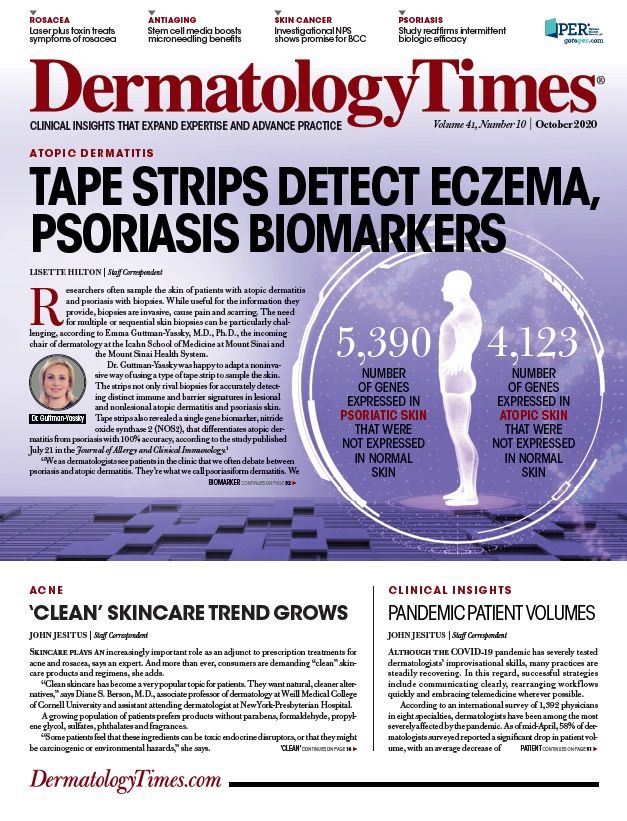- Case-Based Roundtable
- General Dermatology
- Eczema
- Chronic Hand Eczema
- Alopecia
- Aesthetics
- Vitiligo
- COVID-19
- Actinic Keratosis
- Precision Medicine and Biologics
- Rare Disease
- Wound Care
- Rosacea
- Psoriasis
- Psoriatic Arthritis
- Atopic Dermatitis
- Melasma
- NP and PA
- Skin Cancer
- Hidradenitis Suppurativa
- Drug Watch
- Pigmentary Disorders
- Acne
- Pediatric Dermatology
- Practice Management
- Prurigo Nodularis
- Buy-and-Bill
Publication
Article
Dermatology Times
Stem cell media boosts microneedling benefits
Author(s):
A split-face study investigating facial rejuvenation found better outcomes using microneedling followed by topical application of a stem cell derived conditioned media versus microneedling alone.
Microneedling is an efficient method for facial skin rejuvenation, but the outcomes are augmented by using a combined approach that incorporates topical application of amniotic fluid mesenchymal stem cell derived conditioned media (AF-MSC-CM), according to a split-face comparative study.1
The study enrolled 10 patients with mild to moderate signs of photoaging who underwent five treatment sessions under topical anesthesia at 2-week intervals. Microneedling with a dermaroller was performed over the entire face. There- after, 1 mL of AF-MSC-CM (BIO STEM CM Cell Signal Therapy Wrinkle Control kit, Bio Innovation Holdings) was applied to the right side only.
Assessments performed at one month after the last treatment showed significant clinical and histological improvements bilaterally. However, there was greater clinical improvement and better remodeling of dermal collagen and elastic fibers on the right side of the face.
“Although our study included just ten patients, the split-face design enabled our ability to detect a treatment benefit from adding AF-MSC-CM,” says Moetaz El-Domyati, M.D., Professor of Dermatology, Minia University, Al-Minya, Egypt. “We believe that stem cell therapy represents the future for facial rejuvenation and managing aging skin."
Study rationale
As a nonablative procedure that causes selective dermal injury, microneedling by itself is a safe and effective technique for inducing skin tightening. In addition, it is relatively inexpensive and does not involve significant downtime.
The AF-MSC-CM can also promote skin rejuvenation because it is a rich source of growth factors, chemokines, and cytokines, including vascular endothelial growth factor, transforming growth factor-β, interleukin (IL)-6, IL-8, and tumor necrosis factor-α, that have been shown to be upregulated during the inflammatory phase of the wound healing process.
“Although topically applied growth factors and cytokines can increase skin remodeling, their penetration into the skin may be limited because of their large molecular size. Skin microneedling prior to application of AF-MSC-CM creates a route for enhanced transdermal delivery,” Dr. El-Domyati explains. “In contrast to use of embryonic stem cells, the AF-MSC-CM avoids ethical issues, has low immunogenic potential, and can be differentiated with a high degree of expansion and regeneration without culture.”
Study results
The 10 study participants included three males and seven females, and they had a mean age of 50 years. Seven patients had Fitzpatrick skin type IV and three were Fitzpatrick skin type III. Facial aging at baseline based on the Glogau classification system was II or III.
Patients were assessed for adverse events at each visit. The only issues recorded were post-treatment erythema and edema that resolved within 1 to 2 days.
“Because microneedling creates only minute holes in the epidermis, it is associated with minimal to no risk of post-inflammatory hyperpigmentation,” Dr. El-Domyati says.
The assessments of clinical improvement from baseline were done by two blinded dermatologists who compared photographs obtained at baseline and one month after the last treatment. They rated changes using a five-point scale (none = 0%, mild = 1-25%, moderate = 26-50%, good = 51-75%, and very good = 76-100%).
Mean percent improvement from baseline was 33.2% on the left side of the face and 60.6% on the right side. The difference compared with baseline was statistically significant for both sides of the face, but significantly greater on the right side versus the left. On the left side of the face, three patients were rated as having mild improvement and seven achieved moderate improvement. On the right side of the face, the clinical improvement was rated as moderate in two patients, good in seven patients, and very good in one patient.
“All patients benefited with improvement in crow’s feet wrinkles and seven patients also showed improvement in skin texture. Improvement in forehead wrinkles was observed, but to a lesser degree than wrinkles in the crow’s feet area and in only 50% of patients,” Dr. El-Domyati says.
Although they were not aware of which side of the face was treated with the AF-MC-CSM, patients were asked to rate their overall treatment satisfaction rather than separately for each side of the face. Six patients were “completely satisfied”, two were “somewhat satisfied” and two were “unsatisfied.”
Histological changes were assessed by com- paring findings on pre- and post-treatment biopsies taken with a 3 mm punch probe from the temporal area. The histology showed positive changes on both sides of the face that included increased number and organization of collagen bundles, decreased interfibrillary spaces, decreased elastotic material, and the development of fine and well-arranged elastic fibers. However, the changes were greater on the right side of the face.
Epidermal thickness was also measured and found to increase significantly from baseline on both the microneedling alone and combination treatment sides. The difference between the two sides was not statistically significant.
Disclosures:
Dr. El-Domyatihas no relevant financial interest to disclose.
References:
1. El-Domyati M, et al. Facial rejuvenation using stem cell conditioned media combined with skin needling: A split-face comparative study. J Cosmet Dermato. 2020 Jul 5. [Epub ahead of print]. doi: 10.1111/jocd.13594






